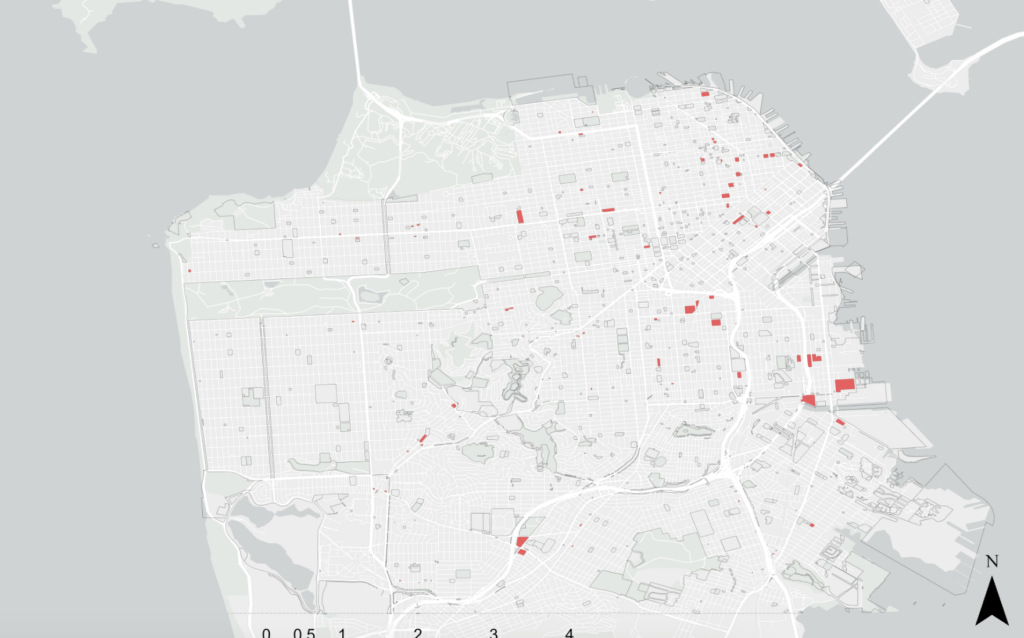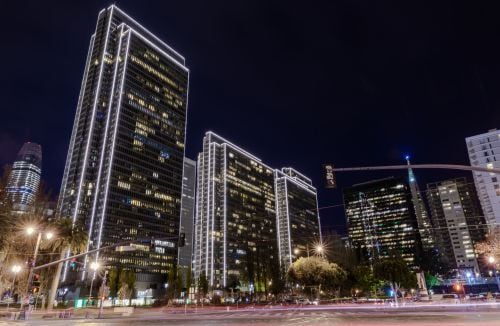SFMTA owns more land than the Winnie the Pooh crew inhabits– 110 acres and 90 properties, to be exact. If they let developers build on it, could it solve their financial problems? Or is it a money grab from greedy developers who are going to exacerbate wealth inequality?
What Land Does SFMTA Own?
SFMTA, our transit authority in San Francisco, has jurisdiction over land throughout The City, mostly related to transportation. This land includes bus depots, parking garages, and surface parking lots. Here’s a map:

Map screenshotted from SFMTA’s excellent ArcGIS story, which can be accessed here.
Supervisor Myrna Melgar has proposed that if SFMTA develops that land, it should explicitly be for funding. In a quote to the Chronicle, Melgar explains, “Every community is going to want something out of the MTA — open space, child care, affordable housing, whatever — and these things are important, but I don’t think these things are MTA’s primary responsibility. The primary responsibility is to be a financially sound agency that transports people around.”
Why Is It Controversial?
Supervisor Melgar explains, “It’s got six supporters or co-sponsors, so it’s going to pass, but it’s not without controversy. I imagine a couple of my colleagues will vote no.” One of them is likely to be Supervisor Walton.
When we noted that we spoke with DSA SF, who helped elect Supervisor Jackie Fielder (an ostensibly more-leftist leaning member of the Board of Supes) Melgar was on the defense. “They had a really interesting perspective,” this reporter noted. “The wrong perspective,” Melgar interposed. But is that true?
What Does the DSA Think?
Members of the DSA that we spoke to agreed a compromise like Melgar is suggesting might be the only path forward. “We would love if The City funded 100% affordable on all its land,” DSA SF co-chair Victoria Barnett says, but the more likely scenario is a mix.
“In the case that that doesn’t happen, which we think is likely, we are also in favor of a mixed model of some amount of the units going to higher incomes. We don’t necessarily see this as a conflict between wanting money for Muni and wanting state money to go towards residents. It can be a win-win.”
Although DSA members have not yet voted on this item, steering committee member Aditya Bhumbla agrees. “It’s reasonable that SFMTA would want to develop on the land that they own. The question there is, how much profit would MTA extract out of renters to fund operations? There’s two groups of people that we want to subsidize, low-income renters and transit riders. And there’s a balance there.”
Bhumbla explains, “We’ve seen evidence that transit operators developing land they own can provide a sustainable revenue source for the transit agency, which is good. We want that.” Transit funding comes from a few different places, the least preferable being fares.
Why Not Fares
When fares go up, public transit is less accessible. Funding for Muni can also come from places like the General Fund and parking garage revenue. “All of those have their own political conditions,” Bhumbla explains. “Fares are the most regressive way to do this. We don’t want to raise fares.”
That might mean a landslide, instead of a simple majority, at next week’s BoS meeting. “Oh!” Melgar exclaims. “There you go. Twice! Twice this week me and the DSA are aligned.” It remains to be seen if this is a deepening schism between progressives who don’t consistently vote together (see the Fentanyl vote that expanded Mayor Lurie’s power and the vote that kicked out police commissioner Max Carter Oberstone for not playing ball with said mayor) or a sign of a healthier board dynamic.
Transit Oriented Development
Barnett says she is “very much in favor of any kind of public and social housing and the local transit system. Both are necessary for working class people in this city. We think TOD (transit-oriented development) is a model that has helped justify new public ownership or development of land for public ownership, which is a very good start.”
Policy papers have shown that the ideal path is a mixture of income levels, where the higher-paying units can help subsidize the others.
Will It Be Rent-Controlled?
“We haven’t aligned or voted on this,” Barnett reiterates.
“If we’re doing public housing, we need to take the public part of that seriously and be accountable to the public,” says Bhumbla. “The catch there is that this is being proposed as a revenue generator, and that will bring pressures to adjust rents over and over again.” Bhumbla clarifies, “DSA would have to be on the side of the tenant.”
Supervisor Melgar says that state law prevents us from having that conversation at the local level, at least in legislation, because currently anything built after 1979 is not eligible for rent control in SF. But SFMTA might be able to make that determination on their own.
Will The City Operate It?
“Just because we own it doesn’t mean we have to operate it,” Melgar says. For example, Westfield Mall is on land owned by SFUSD, and teachers don’t run the shops in the mall.
“Every other city in the world has these stations that maximize the user experience but also commerce. You can take your train to work in the morning and drop off your dry cleaning, come home and pick up dinner for your family,” describes Melgar. “There’s stuff in the stations that you can interact with economically. We don’t have that. We’ve never really maximized the stuff in the train station.”
Why Melgar?
“There’s all these parking lots all over the city, and mostly in my district on the West Side,” Melgar explains. “The thing about the deficit for Muni is that it’s a structural deficit that’s been building for the past 16 years. It’s not a pandemic thing. People drive less, they park less in MTA parking lots, particularly downtown. They’re taking more Uber, Lyft, and Waymos.”
Our parking revenue is down and it’s down by almost the same as our structural deficit. This year, it’s $270,000 and our structural deficit is $300,000. “It was a trend that we failed to address,” Melgar continues. “I don’t think we’re ever going to go back. Gen Z has a much lower rate of car ownership than my generation or the Baby Boomers. It’s on us to figure out that structural issue… We need to use [these assets] for the fiscal health of the MTA.”
Enterprise Agencies
A few agencies, including the airport, the PUC, and the Port of San Francisco, are deemed enterprise agencies. That means they’re allowed to generate profit. The airport, Melgar explains, makes $100 million a year for the city that goes into our general fund. “It’s our cash cow.”
If SFMTA is expected to sacrifice the equity and hand over this valuable land, it’s essentially asking them to behave differently than the other enterprise agencies, who are able to collect money from people who get a massage at the airport or enjoy a meal at a restaurant down at the port.
Melgar doesn’t want to prescribe how SFMTA proceeds, “because that’s above my pay grade,” she jokes, but she points out that rentals are going to generate money over time. If the land is sold, it might not be as fruitful. “Once you sell something, somebody else owns the equity and if there’s appreciation or an increase on the rent, somebody else gets it.”
But she describes other developments where the City retains the land ownership and leases it on a 50 or 99 year term. “If it’s housing, it’s subject to the exact same requirements as any other development,” she assures. So 25% of units, at least, will be affordable. She notes that the pandemic reduction in that percentage is set to expire in 16 months. “[My resolution] doesn’t prohibit affordable housing. In fact, we can build 100% affordable housing — just as long as the equity is not used for subsidy.”
The Elephant in the Room
The Potrero Yard development at 16th and Bryant is an example of what might happen with affordable housing. “The problem is, they can’t finance it,” Bhumbla puts bluntly. “The financing isn’t coming through.” Of note: This development is in Supervisor Walton’s district.
“I think that folks are upset because maybe they feel criticized over the project that we’ve done,” Melgar speculates. “[This proposal is] not meant as a criticism.”
Bhumbla describes what is stalling the Potrero Yard development. “This is me speaking personally – those units will not recoup their operating costs, so you need to get a subsidy from somewhere else,” they say. And while that’s very much desired, it’s an uphill battle. “The state has all this money to give to cops, all this money to give to the military. We should be subsidizing housing, but that’s a bigger political shift.”
It’s been done but it’s also been difficult. “Because we’ve gotten those projects,” Supervisor Melgar postulates, “I think people want to keep the door open for more. The problem is this. MTA is broke, and it has all of these assets that are under-utilized.”
The DSA members describe Supervisor Walton’s position as noble but not necessarily feasible. In the meantime, the compromise might help accomplish a small addition of affordable housing units. “If we can capture subsidies from higher income renters to cross-subsidize lower income renters, that’s better than the higher income renters giving their rent to landlords and that money gets taken out of the public realm.”
Will Development Happen Immediately?
According to the SFMTA’s Joint Development Program website, “Each site would also go through a public engagement process and many city approvals before breaking ground.”
Ultimately, what might hold things up is a philosophical question: Should The City’s land be used for 100% affordable housing? Or is it possible that making 25% of units Below Market Rate and the rest priced normally could fund our beloved Muni?
Supervisor Walton did not respond to a request for comment by the time of this publication. Votes will take place on Tuesday, March 3.
The post Can SFMTA Save Itself By Developing Housing on Parking Lots? appeared first on Broke-Ass Stuart's Website.







